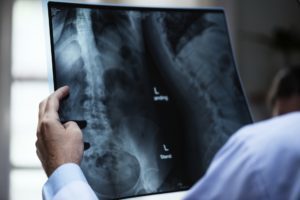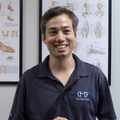
Osteoporosis is largely a lifestyle disease, not nearly as common in the archaeological record of our primitive ancestors as it is in today’s modern societies. Insidious and asymptomatic during its initial development, osteoporosis silently develops without much alarm in its early stages. The resultant pernicious bone loss turn our bodies into “fragile, handle with care” packages, exposing one to:
- Increased risk of fractures
- Impairment/disability
- Loss of height
- Postural distortion
- Fragility
Our bones run on a “strain for gain”, “use it or lose it” economy. The more active you are when you’re young the more total bone mass you’ll develop and have in the “bank” when you’re older. Therefore, an active lifestyle during youth leads to greater bone mass throughout life, while an active lifestyle when one is older, allows one to keep or slow the depletion of bone mass.
Bone density is regulated by two cell types which help remodel our bones throughout life, via a delicate balance of bone resorption and bone deposition. The two cell types in our bodies are known as:
- Osteoblasts: bone depositing cells
- Osteoclasts: bone absorbing cells
There’s multiple factors which influence the activity of these cells such as:
- Age
- Physical activity
- Hormones
- Sex
- Diet
As Daniel Lieberman points out in his book The Story of the Human Body, the worse case scenario for developing osteoporosis would be a confluence of the factors above. The prime example would be as follows:
A post-menopausal woman who wasn’t very physically active when she was younger, isn’t physically active now, has a diet poor in calcium, is vitamin D deficient, and to top it off, is a smoker.
Here’s why this combination of factors leads to osteoporosis
- Age – During the aging process our osteoblasts build a bony matrix, which after skeletal maturity, focuses on really maintaining not necessarily full rebuilding. The osteoblasts and osteoclasts become good at “refurbishing” but not “new construction”.
- Physical activity – As mentioned earlier, the more we stress our bones with physical activity when we’re young, the more bone mass we’ll have later in life. Continuing physical activity helps us maintain or slow the loss of the bone mass. For many of us in modern society, physical activity is something that needs to be programmed in and is not necessarily part of our jobs or daily activities.
- Hormones – Estrogen increases osteoblast activity while also decreasing osteoclast activity. Testosterone is converted to estrogen in bone, so testosterone levels are also important.
- Sex – Females are at higher risk than males for osteoporosis, since estrogen plays a large role in regulating osteoblast and osteoclast activity. Although men are less affected, they are not immune. As men age, their levels of testosterone drop, so less can be converted to estrogen to regulate bone density.
- Diet – Calcium rich foods are less abundant in modern high grain diets. Vitamin D helps the absorption of calcium and in recent years, it’s become apparent that vitamin D inefficiency is high in our modern society.
Drugs and hormone replacement therapies, designed to balance bone resorption and bone deposition, are geared more for managing instead of preventing osteoporosis. Prevention is still our best strategy for maintaining bone density. Lifestyle remains the key to prevention, primarily through proper nutrition and exercise throughout our lives.
Nutrition is an essential part of bone health and the prevention of osteoporosis. Minerals and vitamins that have been identified as essential for bone health are as follows:
- Calcium
- Vitamin D
- Phosphorous
- Vitamin K
- Strontium
- Magnesium
Calcium, along with phosphorus, makes up the mineral content of bone. Our bones store about 99% of our calcium and about 80% of our phosphorus. Calcium along with Vitamin D supplementation have been well researched and proven to be key therapeutic components to the management and prevention of osteoporosis ( Bojour et. al 2009).
Daily calcium intake from our food and supplementation in the United States is recommended as follows:
- Women
- 50 and younger – 1,000mg per day
- 51 and older – 1,200mg per day
- Men
- 70 and younger – 1,000mg per day
- 71 and older – 1,200mg per day
The majority of our daily calcium intake comes from our food. To understand your individual need for supplementation a helpful tool is the International Osteoporosis Foundation’s calcium calculator.
Vitamin D plays a large role in Calcium absorption. Our major sources of vitamin D are sunlight exposure, followed be fatty fish, fish liver oils and the fat from fish eating animals (Bonjour 2009).
Daily vitamin D needs:
- Men and Women
- Under the age of 50: 400-800 International Units
- Age 50 and older: 800-1,000 International Units
It’s been suggested by different groups that the upper levels of Vitamin D can be increased significantly since they were last set in 1997 and new research has been done. Upper levels have been suggested as high as 10,000 International Units.
Calcium and Vitamin D supplementation have been shown effective in managing osteoporosis and reducing associated fragility fractures. However, their benefit still requires physical loading of human body (i.e. exercise).
As stated earlier, exercise early in life has been shown to increase bone growth, while later in life, it has been shown to help maintain the bone density we’ve gained in our youth. In general, the more impact on the skeleton the greater the impact on our bone mass. However, this must be weighted with age and risk for injury. Swimming has little impact on bone mass, walking and running have more impact on bone mass, and jumping and weight training have the greatest impact on bone mass.
Practical Recommendations(Gaudalupe-Graur 2009):
- Train in high impact sports when you’re young in order to maximize bone mass.
- Continue physical activity throughout life, focusing on loading bones susceptible to osteoporotic fractures such as the mid back, lower back, and hips.
- Train with resistance/weights with the following in mind:
- Frequency: 3-6 days per week
- Volume: close to maximum effort in 2-3 sets
- Movement: Proper biomechanics and form are emphasized over speed; however if form is maintained, speed of movement can be increased
In conclusion osteoporosis is a worldwide problem in today’s modern society with significant quality of life issues including pain, fracture, and disability. Lifestyle changes can play a significant role in arresting it’s development. Nutrition and physical exercise play a key role in its prevention and management. More research is needed along with more campaigns promoting lifestyle interventions for osteoporosis and other preventable diseases.
©CenterForMusculoskeletalFunction2018
References
Bonjour, J., Guéguen, L., Palacios, C., Shearer, M. J., & Weaver, C. M. (2009). Minerals and vitamins in bone health: the potential value of dietary enhancement. British Journal of Nutrition, 101(11), 1581. doi:10.1017/s0007114509311721
Guadalupe-Grau, A., Fuentes, T., Guerra, B., & Calbet, J. A. (2009). Exercise and Bone Mass in Adults. Sports Medicine, 39(6), 439-468. doi:10.2165/00007256-200939060-00002
Home – National Osteoporosis Foundation. (n.d.). Retrieved from http://www.nof.org
Lieberman, D., & Runnette, S. (2013). The Story of the human body: Evolution, Health, and Disease. New York: Books on Tape.







